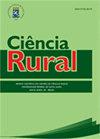Acid resistance of Salmonella Typhimurium ATCC 14028 after desiccation stress during peanut storage
IF 0.9
4区 农林科学
Q3 AGRONOMY
引用次数: 0
Abstract
ABSTRACT: Salmonella is a relevant pathogen, which causes foodborne outbreaks associated with both high and low moisture foods (LMF). This study evaluated the effect of previous desiccation stress on the acid resistance of S. Typhimurium ATCC 14028 using blanched peanut kernels as an LMF model. Salmonella was recovered from the peanut samples throughout 180 days of blanched peanut kernels storage at 28 ºC. During this period two death rates were verified, 0.04 log cfu/g/day in the first 30 days and 0.007 log cfu/g/day between 30 and180 days.Regarding acid resistance, there was no difference (P > 0.05) in the Salmonella growth/death kinetics between the undesiccated sample (TSB)and the cells recovered from peanut samples over 180 days of storage after 4 h at pHs 3.0, 3.5, 4.5 and 7.2. The average growth rate observed for pH 7.2 was 0.44 log cfu/ml/h. At pH 4.5, the Salmonella counts did not change significantly over 4 h. In contrast, Salmonella populations declined by 0.14 to 0.29 log cfu/ml/h at pH 3.5. At pH 3.0 declines were estimated to be 0.65 log cfu/ml/h for the undesiccated sample and 2.07 log cfu/ml/h for Salmonella recovered from peanuts stored for 120 days. Therefore, our data indicated that desiccation stress caused during the peanut storagedid not influence the Salmonella acid resistance.花生贮藏干燥胁迫后鼠伤寒沙门菌ATCC 14028的耐酸性
摘要:沙门氏菌是一种与高、低水分食品(LMF)相关的致病菌,可引起食源性暴发。本研究以花生焯水花生仁为LMF模型,评价了前期干燥胁迫对鼠伤寒沙门氏菌ATCC 14028耐酸性的影响。在28ºC条件下,花生仁经过180天的焯水保存,沙门氏菌得以从花生样品中恢复。在此期间,验证了两种死亡率,前30天的死亡率为0.04 log cfu/g/天,30至180天的死亡率为0.007 log cfu/g/天。在耐酸性方面,未干燥样品(TSB)与花生样品中回收的细胞在ph为3.0、3.5、4.5和7.2的条件下保存4 h后,沙门氏菌的生长/死亡动力学无显著差异(P < 0.05)。pH值为7.2时的平均生长速率为0.44 log cfu/ml/h。在pH为4.5时,沙门氏菌数量在4 h内没有显著变化,而在pH为3.5时,沙门氏菌数量下降了0.14 ~ 0.29 log cfu/ml/h。在pH为3.0时,未干燥样品的沙门氏菌下降量估计为0.65 log cfu/ml/h,花生中保存120天的沙门氏菌下降量估计为2.07 log cfu/ml/h。因此,我们的数据表明,花生储存过程中引起的干燥胁迫对沙门氏菌的耐酸性没有影响。
本文章由计算机程序翻译,如有差异,请以英文原文为准。
求助全文
约1分钟内获得全文
求助全文
来源期刊

Ciencia Rural
AGRONOMY-
CiteScore
1.70
自引率
0.00%
发文量
233
审稿时长
2-4 weeks
期刊介绍:
The purpose of Ciência Rural is to publish the results of original research, note and reviews which contribute significantly to knowledge in Agricultural Sciences. Preference will be given to original articles that develop news concepts or experimental approaches and are not merely repositories of scientific data. The decison of acceptance for publication lies with the Editors and is based on the recommendations of Editorial Comission, Area Committee and/ or ad hoc reviewers. The editors and reviewers are external to the institution.
 求助内容:
求助内容: 应助结果提醒方式:
应助结果提醒方式:


